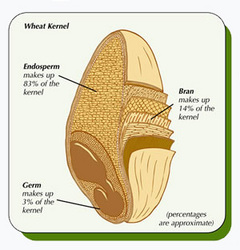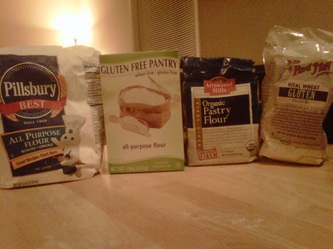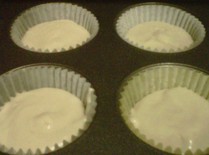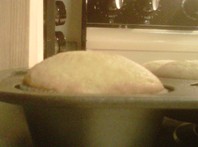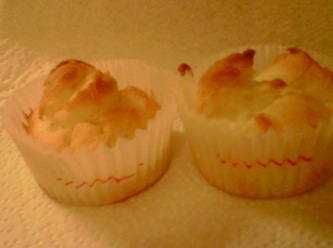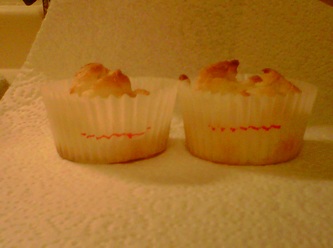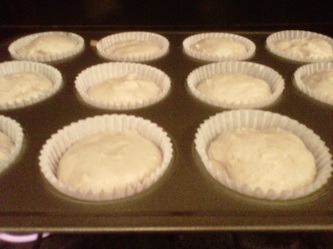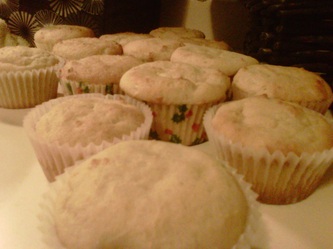I'll post all my findings of my FrankenCake experiment here on this page. Hopefully I'll find a flour that I like the most (based on rise height, moisture, and taste of course!).
The actual scientific process for this experiment can be found here:
| Frankencake Procedure |
The recipe I'm going to use is as follows:
Ingredients
• 2 1/4 cups all purpose flour*
• 1 1/3 cups sugar
• 3 teaspoons baking powder
• 1/2 teaspoon salt
• 1/2 cup shortening
• 1 cup milk
• 1 teaspoon vanilla
• 2 large eggs
• 1 1/3 cups sugar
• 3 teaspoons baking powder
• 1/2 teaspoon salt
• 1/2 cup shortening
• 1 cup milk
• 1 teaspoon vanilla
• 2 large eggs
Directions
Easy Cupcake Recipe Directions
Preheat oven to 350 degrees. Line cupcake pans with paper liners.
Combine flour, sugar, baking powder, and salt in a large mixing bowl. Add shortening, milk, and vanilla. Beat for 1 minute on medium speed. Scrape side of bowl with a spatula.
Add eggs to the mixture. Beat for 1 minute on medium speed. Scrape bowl again. Beat on high speed for 1 minute 30 seconds until well mixed.
Spoon cupcake batter into paper liners until 1/2 to 2/3 full.
Bake for 20 to 25 minutes or until toothpick inserted in center comes out clean.
Cool 5 minutes in pans then remove and place on wire racks to cool completely. (found here)
Preheat oven to 350 degrees. Line cupcake pans with paper liners.
Combine flour, sugar, baking powder, and salt in a large mixing bowl. Add shortening, milk, and vanilla. Beat for 1 minute on medium speed. Scrape side of bowl with a spatula.
Add eggs to the mixture. Beat for 1 minute on medium speed. Scrape bowl again. Beat on high speed for 1 minute 30 seconds until well mixed.
Spoon cupcake batter into paper liners until 1/2 to 2/3 full.
Bake for 20 to 25 minutes or until toothpick inserted in center comes out clean.
Cool 5 minutes in pans then remove and place on wire racks to cool completely. (found here)
The scientific break down of experiment #1 can be found here:
| All Purpose Results |
Gluten Free flour, experiment 2
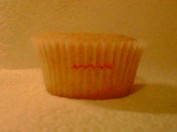
Last night I decided to set out on my flour experiment again. This time I cut the recipe in half, splitting it between the gluten free flour and the pastry flour (as shown in experiment 3). I filled them up half way (as noted by the red line drawn on the cupcake liner). They only rose to the tippy top of the liner, an over all 1/2" higher than the batter.
Despite their lack of puff factor, these ones actually turned out great! The batter using the gluten-free flour was a little grainy, and the color is a little more brown (since this is also organic flour and not bleached). They didn't taste any different than the all purpose flour, just a slightly grittier texture. I added a little raspberry to the guideline recipe,
I plan on topping them with chocolate ganache and fondant tonight!
Despite their lack of puff factor, these ones actually turned out great! The batter using the gluten-free flour was a little grainy, and the color is a little more brown (since this is also organic flour and not bleached). They didn't taste any different than the all purpose flour, just a slightly grittier texture. I added a little raspberry to the guideline recipe,
I plan on topping them with chocolate ganache and fondant tonight!
The scientific break down of experiment #2 can be found here:
| Gluten Free Results |
Pastry flour, experiment 3
I used the other half of the recipe from the gluten experiment for this test (I also added a bit of raspberry to this test run as well, since I am planning on eating and sharing these!). The batter was a little doughy, but tasted great!
I quickly learned that pastry flour has its name for a reason-it's clearly meant for pastries and not cakes. I filled up the cup liners about half way with the batter (noted by the red lines on the liners). Unlike the other batters and normal liquid cake batter, this did not settle very well. Upon being baked, the 'cupcakes' just sat and were baked in their pre-molded positions. The amount of rise was hard to measure, since none of them were level, but it looked to be about 1/2-2/3" average in the batch.
If I could master this batter, I could make wicked awesome cupcakes. The texture turned out a little heavier than angel food cake, but lighter than pound cake. If you just bake them all willy-nilly not caring about their shapes, they would make great desert bases for shortcakes or mini-tortes.
I quickly learned that pastry flour has its name for a reason-it's clearly meant for pastries and not cakes. I filled up the cup liners about half way with the batter (noted by the red lines on the liners). Unlike the other batters and normal liquid cake batter, this did not settle very well. Upon being baked, the 'cupcakes' just sat and were baked in their pre-molded positions. The amount of rise was hard to measure, since none of them were level, but it looked to be about 1/2-2/3" average in the batch.
If I could master this batter, I could make wicked awesome cupcakes. The texture turned out a little heavier than angel food cake, but lighter than pound cake. If you just bake them all willy-nilly not caring about their shapes, they would make great desert bases for shortcakes or mini-tortes.
The scientific break down of experiment #3 can be found here:
| Pastry Flour Results |
Gluten flour, experiment 4
With the final experiment, I tested the gluten flour with the above recipe. The gluten flour is the most dense type of flour, and on the packaging it's recommended to be used in part with bread recipes. When mixing the batter, it seemed to be normal (very similar to the all purpose baking flour). When I started to spoon it into the liners, the dough was sticky and very viscous.
Fearing that the batter would not settle and would bake into odd shapes (like the batter with the pastry flour), I started to roll the dough into balls before placing them into the liners. While baking, the batter rose quickly and had a spherical shape on the top (odd for cupcakes, but if the batter would taste good, this would make them easier to frost later). Turns out that they did settle nicely after sitting in the over for just a few minutes, no odd shapes to be baked.
After the baking was done, the cakes were more like spongy biscuits. When they first came out of the oven, they were puffed up domes, about a whole inch over the top of the liner. As they sat, the cupcake settled and there was a rise of 1/4" for the balled batter, and a 3/8" for the spooned batter. They were elastic-y and mold-able, and the sweet cake-y taste was not there. Although this trial run LOOKED delicious, this flour does not seem to be suitable for baking cupcakes.
1. Before baking, filled about 2. After baking, most looked 3. Left side was spooned batter,
3/4 the way. like great cupcakes! right side was balled batter
Fearing that the batter would not settle and would bake into odd shapes (like the batter with the pastry flour), I started to roll the dough into balls before placing them into the liners. While baking, the batter rose quickly and had a spherical shape on the top (odd for cupcakes, but if the batter would taste good, this would make them easier to frost later). Turns out that they did settle nicely after sitting in the over for just a few minutes, no odd shapes to be baked.
After the baking was done, the cakes were more like spongy biscuits. When they first came out of the oven, they were puffed up domes, about a whole inch over the top of the liner. As they sat, the cupcake settled and there was a rise of 1/4" for the balled batter, and a 3/8" for the spooned batter. They were elastic-y and mold-able, and the sweet cake-y taste was not there. Although this trial run LOOKED delicious, this flour does not seem to be suitable for baking cupcakes.
1. Before baking, filled about 2. After baking, most looked 3. Left side was spooned batter,
3/4 the way. like great cupcakes! right side was balled batter
The scientific break down of experiment #4 can be found here:
| Gluten Results |
Scientific Conclusion of Frankencake
The conclusion and bibliography can be found here:
| Frankencake Conclusion |
